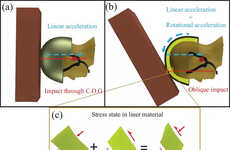
Scientists Develop Means of Making Ultra-Lightweight Wearable Armor
Michael Plishka — April 10, 2010 — Art & Design
References: livescience
We've seen chainmail t-shirts, now scientists at the University of South Carolina have created a wearable armor-type material that is soft, lightweight, stretchy and generally feels like a material. By fusing boron with the carbon in cotton, they were able to create boron carbide material--the same stuff that shields military tanks.
Since this material is fabricated at the nanolevel, this material could be used for any application in which lightweight, tough materials are needed like in cars, planes, emergency shelters and more. Would you rock this wearable armor?
Since this material is fabricated at the nanolevel, this material could be used for any application in which lightweight, tough materials are needed like in cars, planes, emergency shelters and more. Would you rock this wearable armor?
Trend Themes
1. Lightweight Armor - The development of ultra-lightweight and flexible wearable armor opens up opportunities for disruptive innovation in personal protection and military industries.
2. Nanofabrication - The use of nanolevel fabrication techniques in creating advanced materials presents disruptive innovation opportunities in various industries, including aerospace and automotive.
3. High Strength Materials - The synthesis of boron carbide material offers potential disruptive applications in industries seeking lightweight yet strong materials, such as construction and defense.
Industry Implications
1. Personal Protection - The advancements in lightweight and flexible wearable armor can lead to disruptive innovations in personal protection gear for industries like law enforcement and security.
2. Aerospace - The use of nanofabrication techniques in creating strong and lightweight materials can revolutionize the aerospace industry by enabling the production of more fuel-efficient and durable aircraft.
3. Automotive - Integrating boron carbide material into the production of automotive components can disrupt the industry by improving the safety and fuel efficiency of vehicles without compromising their weight or performance.
4.3
Score
Popularity
Activity
Freshness























